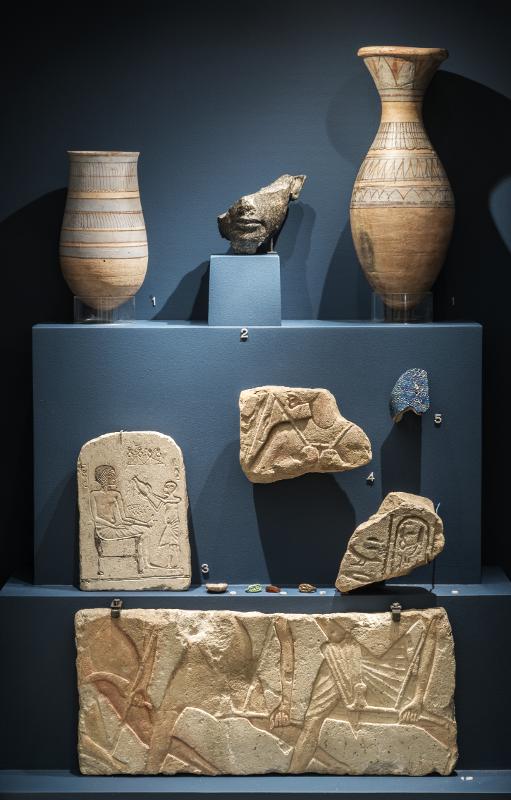| Typ <itemType> |
Utställning |
| Description <itemDescription> |
-
18th Dynasty, the Amarna Period, New Kingdom
The Amarna Period brought significant changes in terms of art. The way in which the king was portrayed was different from earlier customs and traditions. King Akhenaten was shown with a pointed face, a sunken chest, wide hips and the back of his head elongated. This new way of portraying the king was copied by the upper social classes. written languag...
Visa hela
18th Dynasty, the Amarna Period, New Kingdom
The Amarna Period brought significant changes in terms of art. The way in which the king was portrayed was different from earlier customs and traditions. King Akhenaten was shown with a pointed face, a sunken chest, wide hips and the back of his head elongated. This new way of portraying the king was copied by the upper social classes. written language was also modified and adapted to the spoken language.
Queen Nefertiti (meaning ’the beautiful one has come’) had an unusually prominent role. She reigned alongside her husband for some time and was depicted wearing royal crowns and regalia.
King Tutankhamun was the probably the son of King Akhenaten and Kiya, his second wife. Tutankhamun was only a child when he became king and the real power was held by his Commander in Chief, Horemheb.
Having initially borne the name Tutankhaten (’the living image of Aten’), the name of the young king was changed to Tutankhamun. The old order was restored; the city of Akhetaten abandoned, the Aten temples demolished and the temples of other gods restored to their former glory.
Stäng
|
| Description, Swedish <itemDescription> |
-
18:e dynastin, Amarna-perioden, Nya riket
Under Amarna-perioden skedde stora förändringar inom konsten. Sättet av avbilda kungen bröt med all tidigare tradition. Akhenaten framställdes med spetsigt an...
Visa hela
18:e dynastin, Amarna-perioden, Nya riket
Under Amarna-perioden skedde stora förändringar inom konsten. Sättet av avbilda kungen bröt med all tidigare tradition. Akhenaten framställdes med spetsigt ansikte, utdraget bakhuvud, insjunket bröst och breda höfter. Detta nya avbildningsideal kopierades i de övre samhällsklasserna. Även skriftspråket ändrades och anpassades till det talade språket.
Drottning Nefertiti (”Den sköna är kommen”) hade en ovanligt framträdande roll. Hon regerade en tid tillsammans med sin make och avbildades med kungliga kronor och regalier.
Tutankhamon var troligen son till Akhenaten och bihustrun Kiya. Han var bara ett barn när han blev kung och den egentliga makten innehades av överbefälhavaren Horemheb.
Efter att först ha burit namnet Tutankhaten (”Atens levande avbild”) ändrades den unge kungens namne till Tutankhamon. Den gamla ordningen återställdes; staden Akhetaten övergavs, Aten-templen revs och de andra gudarnas tempel återfick sina tillgångar och sitt inflytande.
Stäng
|
| Nyckelord <itemKeyWord> |
|
| Title<itemName> |
- Akhenaten, Nefertiti and Tutankhamun (1372 - 1346 BC)
|
| Title, Swedish<itemName> |
- Akhenaten, Nefertiti och Tutankhamon (1372-1346 f Kr)
|
| Ämne <subject> |
|
| Exhibition, showcase <itemNumber> |
|
| Egypt, Number in Exhibition <itemNumber> |
|
| Previous ID <itemNumber> |
|
| Rättigheter för metadata <itemLicense> |

|
| Källa <presOrganization> |
Statens museer för världskultur - Medelhavsmuseet |
|
Källa <url>
|
|


 ARTIKLAR I WIKIPEDIA
ARTIKLAR I WIKIPEDIA ARTIKLAR I WIKIDATA
ARTIKLAR I WIKIDATA BILDER I WIKIMEDIA COMMONS
BILDER I WIKIMEDIA COMMONS








